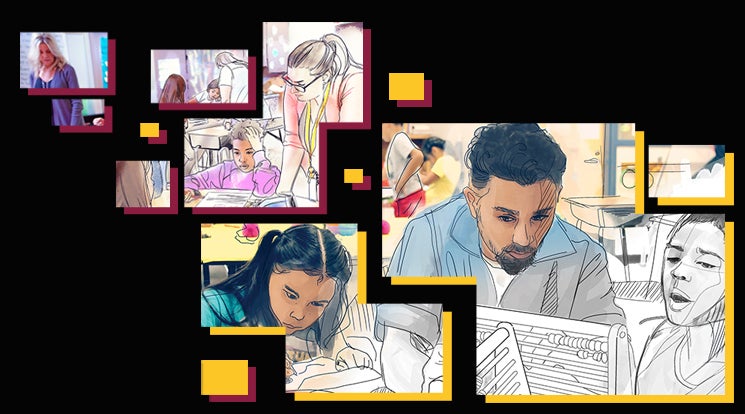What happens when schools adopt Next Education Workforce models?

ASU’s Mary Lou Fulton Teachers College is working with a number of schools in multiple school districts to implement Next Education Workforce models. While the specific shape of these models varies according to those schools’ particular needs, the defining characteristic of Next Education Workforce models is that they bring together teams of educators with distributed expertise in order to deepen and personalize learning for students. They also seek to empower educators by developing new opportunities for role-based specialization and advancement.
Now, with its K–12 school partners, Mary Lou Fulton Teachers College is developing a research agenda in order to generate evidence-based knowledge about the relationships between Next Education Workforce models and outcomes for both learners and educators.
The Next Education Workforce Research Agenda lays out three areas of inquiry for researchers to pursue.
The first area seeks to understand how schools transition from traditional staffing models to Next Education Workforce models, how they implement the new models and what the essential elements are across all models, regardless of school or context.
The second area addresses the connections between those models and the efficacy, diversity and job satisfaction of educators. This is important because one of the objectives of the Next Education Workforce initiative is to increase the effectiveness and retention of educators.
The third area seeks to understand the connections between Next Education Workforce models and students’ academic development, social-emotional growth and capacity to develop rich social networks and a diverse array of relationships with both peers and adults.
Brent Maddin, executive director of MLFTC’s Next Education Workforce initiative, says that among the most pressing insights he hopes to see from the research is an understanding of which, if any, aspects of Next Education Workforce models are applicable to all schools and which are context-dependent. “Understanding that,” says Maddin, “can help us optimize support to districts, schools and teams of educators.”
Andrea Weinberg, an assistant professor at MLFTC, is exploring what she refers to as “the set of necessary readiness conditions schools should meet before building these new staffing models.” She is also asking how the professional development of educators supports the development of new models of teaming.
Jeanne Powers, a professor at MLFTC, is exploring ways in which "the Next Education Workforce iniative presents an exciting opportunity to study a complex reform effort that is starting to scale up." She says, "I am interested in documenting how Next Education Workforce team members and their partner schools co-construct the reform."
Lennon Audrain, a PhD student in educational policy and evaluation at MLFTC, is “exploring the ways that Next Education Workforce models influence the recruitment of high school students from diverse backgrounds to the education profession.”
In the 2021–22 school year, 86 Next Education Workforce teams will be working in 27 schools reaching 6,660 students in five Arizona school districts.
Ultimately, says Maddin, “partnership at this scale will allow us to look for associations between these innovative staffing models and student and teacher outcomes.”
In addition to MLFTC faculty and doctoral students participating in this research, MLFTC is working with external partners. The college has contracted with Johns Hopkins University to serve as an external evaluator to research early implementation and impact of Next Education Workforce models. David Steiner, professor and executive director of the institute for education policy at Johns Hopkins, says, “we are delighted to be able to research this truly important model of teamwork and instruction. Our basic model — one teacher, one classroom, x number of students — hasn’t fundamentally changed since American public education began. Here is a deeply thoughtful effort to rethink how adults interact with children in our schools.”
A partnership with the National Institute for Excellence in Teaching has helped to create an instrument that allows individual teams to discern which elements of Next Education models they are implementing well and identify areas of improvement and growth.
NIET is a nonprofit that has supported teachers, as well as school and district leaders, for more than 20 years. “ASU’s Next Education Workforce initiative recognizes that building educator capacity cannot happen by chance or in isolation to achieve long-term results,” says Josh Barnett, co-president and chief operating officer of NIET. “We look forward to working with the team to expand upon this innovative design that leverages teacher talents across the school to provide opportunities for every student to excel.”
“We have a theory of action about how changes to staffing models in schools can be better for learners and educators,” says Maddin. “We think they can help schools serve learners better. We think they can lead to more diversity among educators, increase teacher retention and ultimately improve teacher and school performance. We are working with schools to implement these models in different ways. So now we have to see what actually happens. We need to understand if there are some conditions in which these models work better than in other conditions.
“Ultimately, we need to prove we’re right about this. Are the models we’re building better for learners and teachers? If so, in what ways? How can we make them work better? We think that is a research agenda worth investing in.”